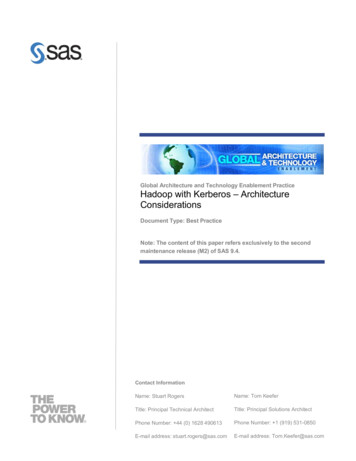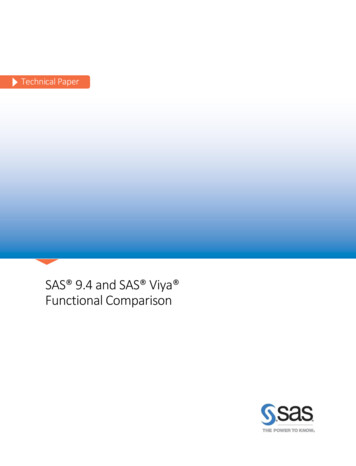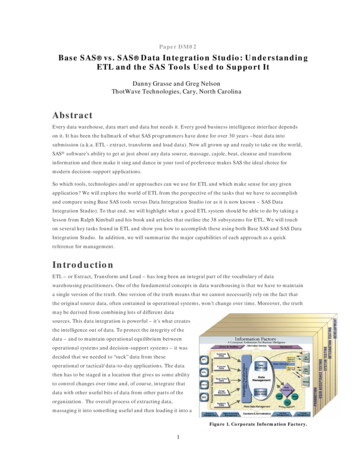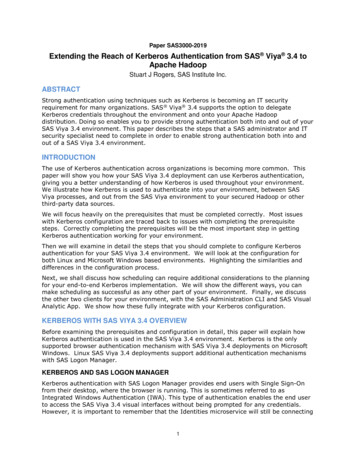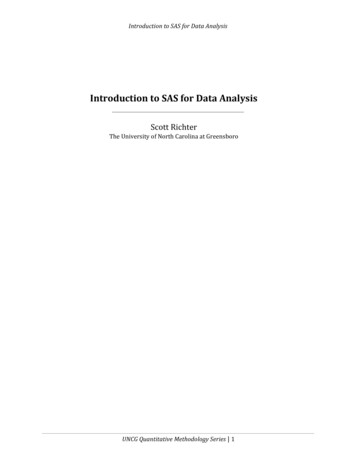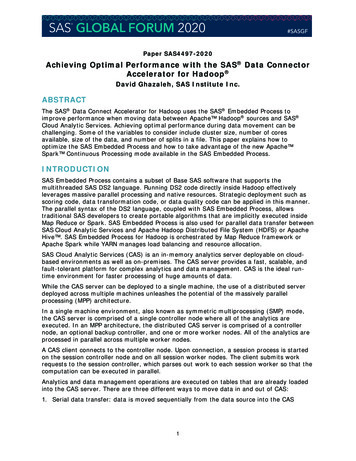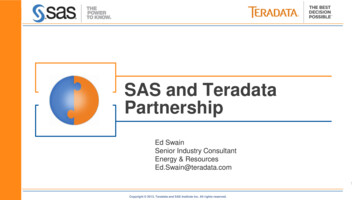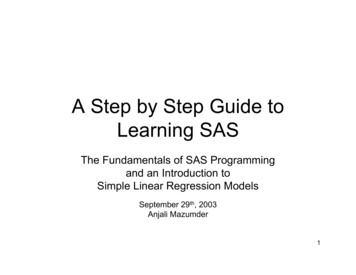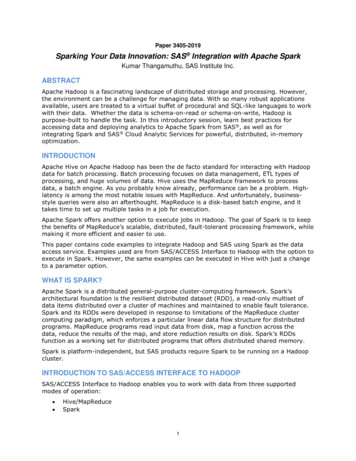
Transcription
Paper 3405-2019Sparking Your Data Innovation: SAS Integration with Apache SparkKumar Thangamuthu, SAS Institute Inc.ABSTRACTApache Hadoop is a fascinating landscape of distributed storage and processing. However,the environment can be a challenge for managing data. With so many robust applicationsavailable, users are treated to a virtual buffet of procedural and SQL-like languages to workwith their data. Whether the data is schema-on-read or schema-on-write, Hadoop ispurpose-built to handle the task. In this introductory session, learn best practices foraccessing data and deploying analytics to Apache Spark from SAS , as well as forintegrating Spark and SAS Cloud Analytic Services for powerful, distributed, in-memoryoptimization.INTRODUCTIONApache Hive on Apache Hadoop has been the de facto standard for interacting with Hadoopdata for batch processing. Batch processing focuses on data management, ETL types ofprocessing, and huge volumes of data. Hive uses the MapReduce framework to processdata, a batch engine. As you probably know already, performance can be a problem. Highlatency is among the most notable issues with MapReduce. And unfortunately, businessstyle queries were also an afterthought. MapReduce is a disk-based batch engine, and ittakes time to set up multiple tasks in a job for execution.Apache Spark offers another option to execute jobs in Hadoop. The goal of Spark is to keepthe benefits of MapReduce’s scalable, distributed, fault-tolerant processing framework, whilemaking it more efficient and easier to use.This paper contains code examples to integrate Hadoop and SAS using Spark as the dataaccess service. Examples used are from SAS/ACCESS Interface to Hadoop with the option toexecute in Spark. However, the same examples can be executed in Hive with just a changeto a parameter option.WHAT IS SPARK?Apache Spark is a distributed general-purpose cluster-computing framework. Spark’sarchitectural foundation is the resilient distributed dataset (RDD), a read-only multiset ofdata items distributed over a cluster of machines and maintained to enable fault tolerance.Spark and its RDDs were developed in response to limitations of the MapReduce clustercomputing paradigm, which enforces a particular linear data flow structure for distributedprograms. MapReduce programs read input data from disk, map a function across thedata, reduce the results of the map, and store reduction results on disk. Spark’s RDDsfunction as a working set for distributed programs that offers distributed shared memory.Spark is platform-independent, but SAS products require Spark to be running on a Hadoopcluster.INTRODUCTION TO SAS/ACCESS INTERFACE TO HADOOPSAS/ACCESS Interface to Hadoop enables you to work with data from three supportedmodes of operation: Hive/MapReduceSpark1
HDMDWith SAS/ACCESS Interface to Hadoop, SAS can read and write data to and from Hadoop asif it were any other relational data source to which SAS can connect. This interface providesfast, efficient access to data stored in Hadoop.In SAS Viya, SAS/ACCESS Interface to Hadoop includes SAS Data Connector to Hadoop. Allusers with SAS/ACCESS Interface to Hadoop can use the serial SAS Data Connector toHadoop. If you have licensed SAS In-Database Technologies for Hadoop, you will also haveaccess to the SAS Data Connect Accelerator to Hadoop. SAS Data Connect Accelerator toHadoop can load or save data in parallel between Hadoop and SAS using SAS EmbeddedProcess, as a Hive/MapReduce or Spark job. To access and process Hadoop data in Spark,SAS/ACCESS Interface to Hadoop uses a PLATFORM parameter option.The SAS Viya Data Connector or SAS Viya Data Connect Accelerator enables you to loadlarge amounts of data into the CAS server for parallel processing. SAS Cloud AnalyticServices (CAS) is the cloud-based run-time environment for data management, distributedcomputing, and high-performance analytics with SAS Viya. A platform for distributedcomputing, CAS can run in the cloud while providing the best-in-class analytics that SAS isknown for.When possible, SAS/ACCESS Interface to Hadoop also does streaming reads and streamingwrites directly from the Hadoop Distributed File System (HDFS) to improve performance.This differs from the traditional SAS/ACCESS engine behavior, which exclusively usesdatabase SQL to read and write data.STORING SAS DATA ON HADOOP CLUSTERSAS/ACCESS Interface to Hadoop uses an HDMD (Hadoop Metadata) mode of operation.When you specify the HDFS METADIR connection option, SAS data sets are persisted onHDFS in a format that can be read directly by SAS. This is a useful way to store largeamounts of SAS data on a low-cost Hadoop cluster. Metadata about the SAS data set ispersisted as a file with the SASHDMD file type. SAS/ACCESS creates SASHDMD metadatawhen it writes output from SAS. As an alternative, the HDMD procedure can create thesemetadata files.SAS/ACCESS INTERFACE TO HADOOP ON SPARK CONFIGURATIONSWe will look at examples that use the MVA SAS LIBNAME statement and CAS CASLIBstatement to connect to Hadoop and process data. The SAS connection to the Hadoopcluster requires two paths on the SAS client to locations containing Hadoop JAR files andHadoop configuration files. Contents for these two paths are gathered using the SASHadoopTracer script.ENVIRONMENT VARIABLESThe following two environment variables are required when connecting to Hadoop using theLIBNAME statement.1. SAS HADOOP JAR PATHSpecifies the directory path for the Hadoop and Spark JAR files. If the pathnamecontains spaces, enclose the pathname value in double quotation marks. To specifymultiple pathnames, concatenate pathnames by separating them with a colon (:) ina UNIX environment.For example, if the Hadoop JAR files are copied to thelocation /third party/Hadoop/jars/lib and Spark JAR files are copied to the2
location /third party/Hadoop/jars/lib/spark, then the following OPTIONSstatement syntax sets the environment variable appropriately:optionsset SAS HADOOP JAR PATH "/third party/Hadoop/jars/lib:/third party/Hadoop/jars/lib/spark";2. SAS HADOOP CONFIG PATHSpecifies the directory path for the Hadoop cluster configuration files. If thepathname contains spaces, enclose the pathname value in double quotation marks.For example, if the cluster configuration files are copied from the Hadoop cluster tothe location /third party/Hadoop/conf, then the following OPTIONS statementsyntax sets the environment variable appropriately.options set SAS HADOOP CONFIG PATH "/third party/Hadoop/conf";These environment variables are not used by CASLIB statements. Hadoop JAR and configpaths are specified as parameters in the CASLIB statement, which we will discuss shortly: hadoopjarpath ”Hadoop and Spark JAR files path”hadoopconfigdir ”Hadoop Configuration files path”CONNECTING TO A HADOOP CLUSTERThere are two ways to connect to a Hadoop cluster using SAS/ACCESS Interface to Hadoop,based on the SAS platform: LIBNAME statement to connect from MVA SASCASLIB statement to connect from CASLIBNAME STATEMENTThe SAS/ACCESS LIBNAME statement enables you to assign a traditional SAS librefconnection to a data source. After you assign the libref, you can reference database objects(tables and views) as if they were SAS data sets. The database tables can be used in DATAsteps and SAS procedures.Here is a LIBNAME statement that connects to a Hadoop cluster:libname hdplib hadoop server "hadoop.server.com"port 10000user "hive"schema 'default'properties "hive.execution.engine SPARK";Here are some important items to note in this LIBNAME statement: Libref – This LIBNAME statement creates a libref named hdplib. The hdplib libref isused to specify the location where SAS will find the data. SAS/ACCESS Engine Name – In this case, we are connecting to Hadoop, so wespecify the HADOOP option in the LIBNAME statement. The SERVER option tells SAS which Hadoop Hive server to connect to. In this case,we are connecting to the Hive server. This value will generally be supplied by yoursystem administrator. The PORT option specifies the port where the Hive server is listening. 10000 is thedefault, so it is not required. It is included just in case.3
USER and PASSWORD are not always required. The SCHEMA option is used to specify the Hive schema to which you want toconnect. It is optional; by default, it connects to the “default” schema. The PROPERTIES option specifies Hadoop properties. Choosing SPARK for theproperty hive.execution.engine enables SAS Viya to use Spark as the executionplatform.76libname hdplib hadoop server "hadoop.server.com"77port 1000078user "hive"79schema 'default'80properties "hive.execution.engine SPARK";NOTE: HiveServer2 High Availability via ZooKeeper will not be used for thisconnection. Specifying the SERVER or PORT libnameoption overrides configuration properties.NOTE: Libref HDPLIB was successfully assigned as follows:Engine:HADOOPPhysical hive.execution.engine SPARKOutput 1. SAS Log Output from a LIBNAME StatementOnce the libref has been created, any data processed, or jobs executed using the libref willuse Spark as the execution platform.CASLIB STATEMENTA caslib is an in-memory space in SAS Viya to hold tables, access control lists, and datasource information. All data is available to CAS through caslibs, and all operations in CASthat use data are performed with a caslib in place.Here is the CASLIB statement to the Hadoop data source with Spark as the executionplatform:caslib splib sessref mysession datasource (srctype "hadoop",dataTransferMode "auto",username "hive",server "hadoop.server.com",hadoopjarpath a/config/data/hadoop/lib/spark",hadoopconfigdir "/opt/sas/viya/config/data/hadoop/conf",schema "default"platform "spark"dfdebug "EPALL"properties "hive.execution.engine SPARK");Here is an explanation of the parameters that are used to create a caslib: CASLIB – A library reference. The caslib is the space holder for the specified dataaccess. The splib cas library is used to specify the Hadoop data source. sessref – Holds the CAS library in a specific CAS session. Mysession is the currentactive CAS session. DATASOURCE Holds Hadoop connection options. A few options are common acrossall data sources, such as SRCTYPE , SERVER , and SCHEMA . There are also4
Hadoop-specific parameters, such as PLATFORM , HADOOPJARPATH ,HADOOPCONFIGDIR . SRCTYPE As you have probably guessed from the name, this option is used tospecify the type of data source that the connection is indented to. DATATRANSFERMODE Specifies the type of data movement between CAS andHadoop. This option accepts one of three values – serial, parallel, auto. When AUTOis specified, CAS choose the type of data transfer based on available license in thesystem. If Data Connect Accelerator to Hadoop has been licensed, parallel datatransfer will be used, otherwise serial mode of transfer is used. USERNAME and PASSWORD are not always required. HADOOPJARPATH Specifies Hadoop and Spark JAR files location path on the CAScluster. HADOOPCONFIGDIR Specifies Hadoop configuration files location path on the CAScluster. These config files are used to connect to Hadoop from CAS. SCHEMA An option that is used to specify the Hive schema to which you want toconnect. It is optional, but by default it connects to the “default” schema. PLATFORM An option that is used to specify the type of Hadoop platform to executethe job or transfer data using SAS Embedded Process. Default value is “mapred” forHive MapReduce. When “Spark” is used, data transfer and job executes as a Sparkjob. DFDEBUG An option that is used to get additional information back from SASEmbedded Process that is used to transfer data in the SAS log. The PROPERTIES Specifies Hadoop properties. Choosing “SPARK” for the propertyhive.execution.engine enables SAS Viya to use Spark as the execution platform.76caslib splib datasource (srctype "hadoop",77dataTransferMode "auto",78server "hadoop.server.com",79hadoopjarpath a/config/data/hadoop/lib/spark",80hadoopconfigdir "/opt/sas/viya/config/data/hadoop/conf",81username "hive"82schema "default"83platform "spark"84dfdebug "EPALL"85properties "hive.execution.engine SPARK");NOTE: 'SPLIB' is now the active caslib.NOTE: Cloud Analytic Services added the caslib 'SPLIB'.NOTE: Action to ADD caslib SPLIB completed for session MYSESSION.Output 2. SAS Log Output from a CASLIB StatementCAS libraries can be part of a session, where users have access to the data source tables forthe lifetime of the temporary session. But if you need to store a caslib permanently, a caslibcan be promoted to a global space where all users can access its tables or data. In fact, bydefault a global library called “public” is available in CAS clusters.The PLATFORM option is used by the SAS Embedded Process to process and execute data inSpark.5
DATA ACCESS USING SPARKSpark provides the ability to read HDFS files and query structured data from within a Sparkapplication. With Spark SQL, data can be retrieved from a table stored in Hive using a SQLstatement and the Spark Dataset API. Spark SQL provides ways to retrieve informationabout columns and their data type and supports the HiveQL syntax.SAS Data Connect Accelerator for Hadoop with the Spark platform option uses Hive as thequery engine that will be used to access Spark data.Using SAS Data Connect Accelerator for Hadoop, data can be loaded to CAS or saved toHadoop from CAS in parallel using the SAS Embedded Process, which is installed on allHadoop cluster nodes. Data movement happens between Spark and CAS through SASgenerated Scala code. This approach is useful when data already exists in Spark and eitherneeds to be used for SAS analytics processing or moved to CAS for massively parallel dataand analytics processing.LOADING DATA FROM HADOOP TO CAS USING SPARKThere are many important reasons to load data from Hadoop to CAS. Processing data inCAS offers advanced data preparation, visualization, modeling and model pipelines, andfinally model deployment. Model deployment can be performed using available CAS modulesor pushed back to Spark if the data is already in Hadoop, an example of which we will seesoon.Here is an example of the code to load data from Hadoop to CAS using Spark:proc casutilincaslib spliboutcaslib casuser;load casdata "gas"casout "gas"replace;run;76proc casutil77incaslib splib78outcaslib casuser;NOTE: The UUID 'b75390d7-065c-9240-806f-2dff63b13e77' is connected usingsession MYSESSION.7979 ! load casdata "gas"80casout "gas"81replace;NOTE: Performing parallel LoadTable action using SAS Data ConnectAccelerator for Hadoop.NOTE: SAS Embedded Process tracking URL:NOTE: Job Status .: SUCCEEDEDNOTE: Job ID .:6
NOTE: Job Name .: SAS CAS/DC Input [in: default.gas]NOTE: File splits. : 0NOTE: Input records .: 0NOTE: Input bytes .: 0NOTE: Output records .: 0NOTE: Output bytes .: 0NOTE: Transcode errors : 0NOTE: Truncations .: 0NOTE: Map Progress .: 0.00%NOTE: Cloud Analytic Services made the external data from gas available astable GAS in caslib CASUSER(demo).NOTE: The Cloud Analytic Services server processed the request in 16.61905seconds.82run;Output 3. SAS Log Output from PROC CASUTIL LOAD data CAS Action StatementDisplay 1. Load Data from Hadoop to CAS Using SparkThe PROC CASUTIL can be used to call many CAS actions to process data. In this case, thetable named “gas” was loaded to the CAS in-memory server, which was made possibleusing the LOAD CAS action.INCASLIB and OUTCASLIB are input and output CAS libraries to read and write datarespectively. “splib” in INCASLIB corresponds to the CAS library created earlier usingCASLIB statement. “casuser” in OUTCASLIB corresponds to the default CAS library of theuser in SAS Viya.From the log file, Data Connect Accelerator for Hadoop was used to move data in parallel toCAS. Display 1 shows that the YARN application executed the work as a Spark job. This waspossible because the CASLIB statement had Platform Spark option specified. The datamovement direction, in this case Hadoop to CAS can be identified using the Spark job name,“SAS CAS/DC Input,” where Input is data loaded into CAS.SAVING DATA FROM CAS TO HADOOP USING SPARKData can be saved back to Hadoop from CAS at many stages of the analytic life cycle. Forexample, data in CAS can be used to prepare, blend, visualize, and model. Once the datameets the business use case, if you want to share it with other part of the organization,data can be saved in parallel to Hadoop using Spark jobs. When a data transfer job isinitiated, Procedure CAS calls SAVE CAS action to move data. Based on the licensed transfer7
mechanism, in this case SAS Data Connect Accelerator to Hadoop initiates a parallelEmbedded Process transfer from CAS worker nodes to Hadoop data nodes.Here is an example of using the SAVE CAS action to move data to Hadoop using Spark:proc cas;session mysession;table.save /caslib "splib"table {caslib "casuser", name "gas"},name "gas.sashdat"replace True;quit;76proc cas;77session mysession;78table.save /79caslib "splib"80table {caslib "casuser", name "gas"},81name "gas.sashdat"82replace True;83quit;NOTE: Active Session now mysession.NOTE: Performing parallel SaveTable action using SAS Data ConnectAccelerator for Hadoop.NOTE: SAS Embedded Process tracking URL:NOTE: Job Status .: SUCCEEDEDNOTE: Job ID .:NOTE: Job Name .: SAS CAS/DC Output [out: default.gas]NOTE: File splits. : 0NOTE: Input records .: 0NOTE: Input bytes .: 0NOTE: Output records .: 0NOTE: Output bytes .: 0NOTE: Transcode errors : 0NOTE: Truncations .: 0NOTE: Map Progress .: 0.00%NOTE: Cloud Analytic Services saved the file gas2 in caslib SPLIB.{caslib SPLIB,name gas}NOTE: PROCEDURE CAS used (Total process time):real time12.67 secondscpu time0.38 secondsOutput 4. SAS Log Output from PROC CASUTIL SAVE Data CAS Action Statement8
Display 2. Save Data from CAS to Hadoop Using SparkData from CAS is saved as a Hadoop table using Spark as the execution platform. As SASData Connect Accelerator for Hadoop is used to transfer data in parallel, individual Sparkexecutors in each of the Spark executor nodes handles data execution for that specificHadoop cluster node.Display 2 shows the SAVE data execution as a Spark job. The Spark job named “SASCAS/DC Output” specifies that the data was moved from CAS to Hadoop.IN-DATABASE SCORING USING SPARKThe integration of the SAS Embedded Process and Hadoop allows scoring code to be rundirectly on Hadoop. Both DS2 and DATA step models can be published and scored insideHadoop. Scoring models in Hadoop can be run with either MapReduce or the Spark2 engine.DS2 supports Apache Spark and JDBC-compliant Hadoop data sources. You can access theSpark data through the SAS Workspace Server or the SAS Compute Server by usingSAS/ACCESS to Hadoop. You can access the Spark data from the CAS server by using SASdata connectors.SCORING DATA FROM CAS USING SPARKPROC SCOREACCEL provides an interface to the CAS server for DATA step and DS2 modelpublishing and scoring. Model code can be published from CAS to Spark and then executedthere via the SAS Embedded Process.PROC SCOREACCEL supports a file interface for passing the model components (modelprogram, format XML, and analytic stores). The procedure reads the specified files andpasses their contents on to the model-publishing CAS action. In this case, the files must bevisible from the SAS client.Here is an example in which the CAS Publishmodel and Runmodel actions are used topublish and execute score data in Spark:%let CLUSTER g/data/hadoop/conf";proc scoreaccel sessref mysess1;publishmodeltarget hadoopmodelname "simple01"modeltype DS29
/*filelocation local */p
In SAS Viya, SAS/ACCESS Interface to Hadoop includes SAS Data Connector to Hadoop. All users with SAS/ACCESS Interface to Hadoop can use the serial SAS Data Connector to Hadoop. If you have licensed SAS In-Database Technologies for Hadoop, you will also have access to the SAS Data Conne

